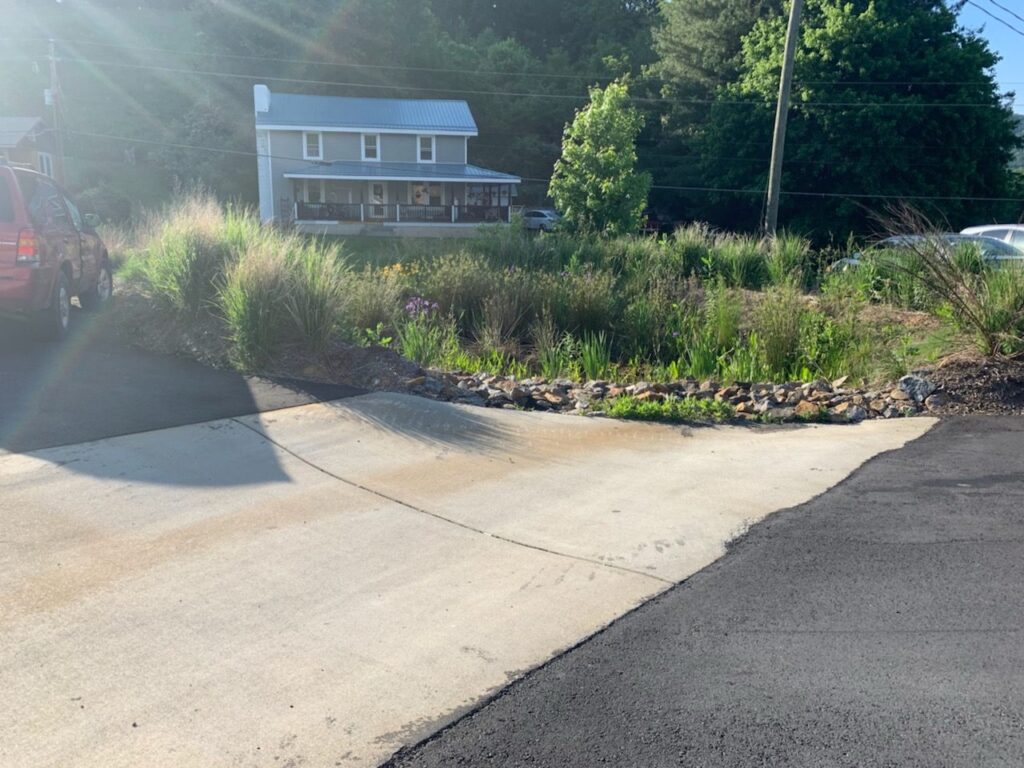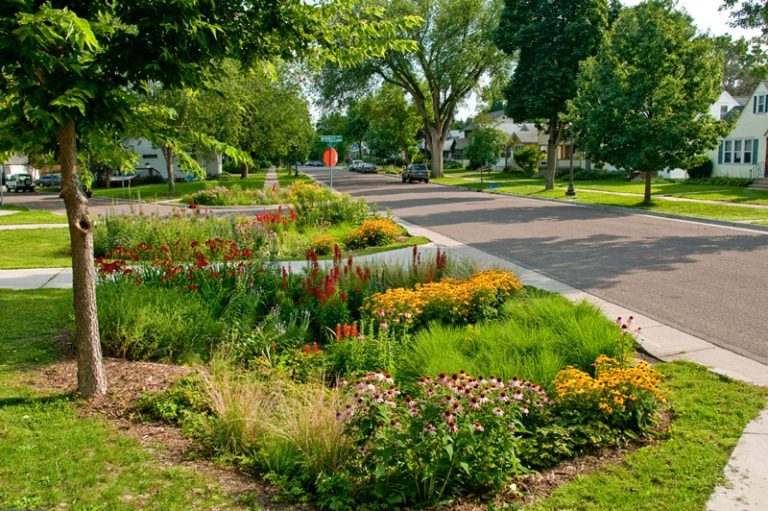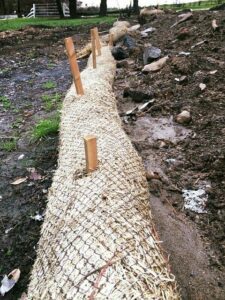Water is one of our most precious resources.
It makes up more than half of the human body, 77 percent of our brains, and covers nearly 70 percent of our earth. Yet, less than 1 percent of the water on earth is drinkable.

With a shifting climate, the amount and distribution of precipitation is changing — and decreasing in many areas. As builders, designers and owners of homes and businesses, we have the opportunity to more fully integrate water into the spaces we interact with, while also cleaning this water before it cycles back into our waterways.
When we build a structure — including covered patios, driveways and roadways — we are reducing the amount of permeable surface on a site and thus increasing runoff. Further, anytime there is a disturbance of land and soil, particularly during construction, there is the possibility for erosion and contamination of waterways.
When we combine machines used to move soil and other construction materials, there is the possibility for pollutants to be carried off site by stormwater. This article discusses the importance of safely filtering and sinking stormwater and other wastewater on site to reduce the negative impacts of sedimentation and pollutants in our waterways.
Working with water on site
The Living Building Challenge Water Petal envisions all future building sites to be net-zero water facilities. This means that all water needs, and subsequent wastewater treatment needs, are met on site. The site must also provide potable water from rainwater, include gray-water and black-water treatment, as well as offer stormwater management.
While current regulations and codes might limit some of the standards outlined in the Water Petal (specifically gray and black water), there are many strategies builders, designers and landowners can use today to get our buildings, and building sites, much closer to the net-zero water goals. We have the opportunity to repair land from construction damage while actually creating a landscape that is more regenerative and resilient than before construction began.
Oftentimes, water that falls in a landscape is piped, or directed, to leave a site quickly. This helps protect building foundations. However, once the water is moved a safe distance from a building’s foundation, we can sink it, slow it and spread it into the landscape.

Soil, plants and mycelium work together to clean and infiltrate water before it leaves our site. They also have the ability to bring fertility and abundance back to a site through creating wildlife habitat, remediating pollutants, using their roots to hold soil in place, and providing an opportunity to grow edible and useful plants for wildlife and humans.
When talking about storing water on site, many people think of installing rain barrels. Rain barrels are great, though many are small and cannot hold much roof water. Alternatively, one of the best places to store water is in the soil.
The current largest pollutant of the local French Broad River is sediment, and the EPA estimates that almost 70 percent of all water pollutants in our waterways are carried by rainwater runoff, according to groundwater.org. Even if your site is clean, when water from your roof moves across other sites, roadways, etc, it picks up oil, chemicals, fertilizers, loose dirt, and more. If we sink more water in our landscapes, less will be available to pick up pollutants and sediment from neighboring sites.
Treatments and techniques
Fortunately, there are a number of techniques we can use to hold and filter water safely on site.
One technique for reducing the load on the stormwater system is through the creation of rain gardens. Rain gardens, or stormwater gardens, are a depression in the soil located on the downhill side of a lawn, roof, driveway or roadway. The soil in the depression is amended to improve permeability and then the area is planted with native plants.
Rainwater infiltrates through the area within 48 hours of a rain event. This prevents the opportunity of mosquito larvae to establish and keeps the area safe since it is free of standing water. Sediment and pollutants are absorbed in the depression as water slowly sinks in the soil and filters out. Some rain gardens, depending on the pollutant load, can include mycoremediation techniques, as discussed below.
Vegetated bioswales are also effective at slowing the flow of water on a site and capturing sedimentation and pollutants. A swale is a trench, or depression, that runs along a site’s contour, or slightly off contour. The soil from the trench creates a berm along the downhill side of the trench. This berm acts like a speed bump, slowing water from uphill.
Similar to a rain garden, water infiltrates the trench, recharging the groundwater as it slowly moves through. The swale is also vegetated and mycoremediation can enhance the treatment of pollutants. Vegetated swales are often used along roadways and parking areas. When they are designed to be slightly off contour, they can slowly direct water away from important infrastructure.
Another type of ‘wastewater’ that leaves a building site is gray water. Gray water is any domestic wastewater that is not sewage. This may include water from a kitchen or bathroom sink, a shower or bath, and from washing laundry.
Considerations that might affect your treatment design include how much gray water the building produces, as well as how you plan to use the gray water. There are examples of using bathroom sink water to fill your toilet basin to be used in the subsequent flush. Other systems use shower and laundry gray water to irrigate perennial plants.
In a simple system, gray water is directed to a gray water-specific pond that is planted with waterloving filtering plants such as cattails, water celery and yellow irises. There are abundant resources available online advising how to set up a gray-water system depending on the inputs and outputs of the system. Please note that gray-water systems are only permitted in North Carolina for specific purposes if it is treated according to code standards.
Mycological magic
Plants, and their mycological allies, have tremendous possibilities for stabilizing soil and removing possible pollutants from the site. When we say mycological, we mean mushrooms!

The more remediating aspects of mushrooms exist in their underground parts, the mycelium. The underground mycelia use enzymes to break down foreign substances, including the hydrocarbons in petroleum products and fuels.
Once you understand how water is moving through a site, you can place inoculated mulch basins that interrupt the flow of water before it moves off site. These basins can be incorporated into rain gardens, vegetated bioswales and gray-water ponds.
A simpler, more temporary option that can be used during and just after construction is the use of wattles. These straw-filled tubes traditionally used to prevent erosion can be inoculated with oyster mushrooms where they slow and clean water as it moves across a disturbed area. They can be removed, or shifted, as other vegetated techniques are employed.
Other techniques worth consideration, depending on the size and location of your building and site, include: submerged, or subsurface, gravel wetlands; stormwater wetland; biofiltration strips; and living, or green, roofs.
In our area, there are plenty of opportunities to include plants that help restore biodiversity, stabilize soil and provide food for people and wildlife. We can help sink, restore and clean site water by designing some of these techniques into our pre- and post-construction sites, and into existing landscapes.
Laura Ruby is the founder of Asheville-based YummyYards and a landscape designer with BareRoot Designs. We are committed to creating holistic spaces where all aspects of the landscape are used to benefit the system as a whole. Connect with Laura at yummyyards.com.
You can also view this article as it was original published on pages 38-39 in the 2019-2020 edition of the directory.

